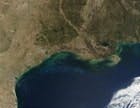The Mississippi River/Gulf of Mexico Watershed Nutrient Task Force is releasing an Action Plan that involves state and federal partners in reducing hypoxia in the northern Gulf of Mexico. The “2008 Action Plan for Reducing, Mitigating, and Controlling Hypoxia in the Northern Gulf of Mexico and Improving Water Quality in the Mississippi River Basin” builds upon the 2001 plan by incorporating emerging issues, innovative approaches and the latest science, including findings from the U.S. Environmental Protection Agency’s (EPA) Science Advisory Board.
“Our improved plan unites governments and citizens across the country to take action upstream and along the coast to reduce river nutrient pollution and increase Gulf of Mexico health,” said Assistant Administrator for Water Benjamin H. Grumbles. “Sound science, cooperative conservation and innovation will accelerate environmental progress throughout the 31-state watershed and this plan puts us on a course to do just that.”
Improvements include more accountability through an annual operating plan, better tracking of progress, state as well as federal nutrient reduction strategies and a plan to increase awareness of the problem and implementation of solutions. The plan connects upstream and downstream problems to solutions in sustaining the Mississippi River Basin and its tributaries.
Nutrients are important to the environment, but too much, particularly nitrogen and phosphorus, can harm water quality by feeding algae blooms and creating oxygen-deprived “dead zones” where marine life cannot survive. Pollution from the whole 31-state Mississippi River watershed is carried downstream to the Gulf of Mexico by the Mississippi and Atchafalaya Rivers. Excess nutrients flowing downstream from agricultural and developed land, soil erosion, factory and wastewater treatment plant discharges and even from the air trigger excessive algal growth that deplete the oxygen in the water when they die, sink to the bottom and decompose.
The task force, made up of state and federal officials, leads efforts to promote and support nutrient management in the Mississippi/Atchafalaya River Basin and works to accelerate efforts to reduce the size of the zone through building strong partnerships, developing voluntary and regulatory approaches and increasing national awareness. EPA is committed to the work of the Task Force and to meeting its ambitious goals through innovative approaches such as numeric nutrient standards in permits, restoring or creating wetlands for purifying runoff and encouraging nutrient cap and trade systems for improved water quality.
More information on the 2008 Action Plan can be found at www.epa.gov/msbasin/.
Source: EPA


